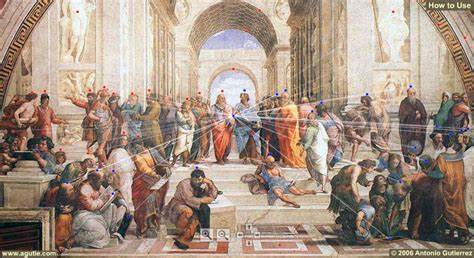Raphael, School of Athens, fresco, 1509 - 1511 (Stanza Della Segnatura, Papal Palace, Vatican)
I have always been captivated by the famous painting "School of Athens" by Raphael. It is one of my favorite works from the Renaissance period. I admire the artist's talent and knowledge that he poured into creating this magnificent piece. It's fascinating to note that Raphael was influenced by Michelangelo's work, especially since Michelangelo was painting the Sistine Chapel ceiling nearby during the High Renaissance.
This painting reminds me of how I used to admire a famous basketball player and tried to emulate his moves after watching his highlights while growing up. I believe "School of Athens" would be a perfect fit for a library, almost like a bookshelf where the philosophers depicted in the painting are the books filled with all the knowledge in the world. I dream of owning a painting like this one day and hanging it over my study room.
I identified four main art elements in this painting. Firstly, the use of color is striking. The two central philosophers, Plato and Aristotle, are depicted in contrasting colors. Plato wears red and purple, symbolizing the ether and fire, which do not have weight. On the other hand, Aristotle wears blue and brown, representing earth and water, which do have weight.
The second and third elements I noticed were shape and form. There are geometric shapes such as squares, rectangles, and cubes throughout the painting. Additionally, I spotted a person holding a globe, which is another type of geometric diagram.
Lastly, the use of line is prominent in the painting. Raphael employed linear perspective to create a sense of depth and space. The central vanishing point, located at the feet of Plato and Aristotle, serves to create the illusion of depth and distance by causing all parallel lines in the painting to converge.
School of Athens. Perspective: Central Vanishing PointRaphael: The School of Athens, 1509. perspective: Central vanishing point (no date) Raphael: The School of Athens. Perspective, Vanishing Point. Interactive Map. Antonio Gutierrez. Available at: https://gogeometry.com/geometric_art/school_athens_perspective.html#:~:text=In%20%22The%20School%20of%20Athens%2C%22%20Rap (Accessed: 16 September 2024).






School of Athens is visually striking with its use of colors. It was interesting to learn the color interpretation of Plato's and Aristotle's robes. The shapes are easily lost behind the sea of color within the people. However, once noticed, they take a solid shape giving the illusion of a 3D building structure. I also noticed the form element being present in the humanoid statues along the geometric shaping. Your included example is quite helpful to fully visualize the depth and space that Raphael was going for.
ReplyDeleteI think that the use of color and line in this piece is really neat, and I didn't know about the symbolism of the specific colors used for Plato and Aristotle, so that's really cool. I also really appreciate how the perspective is used, making the whole scene so much more cohesive than, say, a medieval painting with a crowd of people. And here's a fun fact: The earliest known/surviving painting to use a consistent vanishing point for its perspective is Masolino da Panicale's 𝘚𝘵. 𝘗𝘦𝘵𝘦𝘳 𝘏𝘦𝘢𝘭𝘪𝘯𝘨 𝘢 𝘊𝘳𝘪𝘱𝘱𝘭𝘦 𝘢𝘯𝘥 𝘵𝘩𝘦 𝘙𝘢𝘪𝘴𝘪𝘯𝘨 𝘰𝘧 𝘛𝘢𝘣𝘪𝘵𝘩𝘢, painted circa 1423. Also, the sneaky little self-portrait of Raphael on the far right is just a fun detail.
ReplyDelete